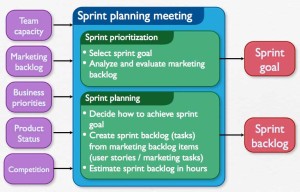 Have you tried introducing Agile Marketing into your organization and met resistance with something like “We can’t afford to do that right now. What we’re doing is too important to take a risk on something new.” Or perhaps the response is some variation of “We’ve always done six month plans and big, year long campaigns and it’s worked fine for us so far.”
Have you tried introducing Agile Marketing into your organization and met resistance with something like “We can’t afford to do that right now. What we’re doing is too important to take a risk on something new.” Or perhaps the response is some variation of “We’ve always done six month plans and big, year long campaigns and it’s worked fine for us so far.”
I get it. Change is hard, and many people resist change.
But I think there is a case to be made that Agile Marketing is less risky than continuing with the status quo.
You Can’t Stop Change
A lot of pundits have been speculating over the last week on why the Republicans and Mitt Romney lost the American presidential election. There are a number of reasons, and I don’t want to get into a debate about politics, but one of the reasons Romney and the Republicans lost is that you can’t stop change. As a nation, we’re becoming more diverse, less white, younger and many of us live in or near large cities. Those constituencies tend to vote Democratic. If your brand is almost exclusively focused on the old-guard, and doesn’t recognize the changes that are taking place in the electorate, you’re going to lose. Change may be hard, but losing is harder.
Of course this isn’t limited to politics. The move from traditional desktop PCs to tablets and smartphones is inexorable; you can’t stop it. Although they’re late, Microsoft has recognized this and their new operating system puts mobile first. If you can’t stop change, you need to learn to adapt to it. Anything else is, in a word, risky.
Agile Marketing recognizes that change pervades the world marketing lives in, and it sees the ability to adapt to change as a source of competitive advantage. For that reason, Agile Marketing is less risky than conventional marketing.
Little Bets
Have you read Peter Sim’s book Little Bets? It makes a convincing case that great innovations come not from a moment of eureka, but from the accumulation of a series of little bets. And little bets are (you guessed it) less risky.
Why put all or most of your budget into one big campaign where you don’t know whether it worked or not for 6-12 months? At that point, you’ve got so much vested in the campaign’s success, it’s only human nature to declare it a success, even if there are no metrics or tangible results.
Agile Marketing is all about little bets, rigorously measured, with results in days or weeks, not months or years. And if some of those bets don’t pan out, that’s OK. You haven’t spent the entire year’s budget. Go out and make another little bet.
The 70-20-10 Model
Neil Perkin introduced me to the 70-20-10 model. Neil explains some of the origins of the model, but basically it comes down to this:
- 70% of what you do should be low risk, bread and butter marketing
- 20% should innovate off what works
- 10% should be high risk ideas that will be tomorrow’s 70% or 20%
You can use this model to make the transition to Agile Marketing in a low risk manner. Take 10% of your budget initially, and devote it to some agile marketing projects. Don’t expect it to work the first time; give it 3 or 4 chances to succeed. Once you see some successes (and you will), then take an additional 20% of your budget and innovate off what worked.
Pretty soon, everyone else in the company will be asking how you did what you did, and they will be clamoring to learn about Agile Marketing.
By the way, this only works if you have a large enough team that breaking off 10% of the resources results in a critical mass of at least 3-4 people. What doesn’t work is to ask everyone to devote 10% of their time to Agile Marketing projects, while they spend 90% of their time on conventional marketing.
What do you think? Have you been faced with skeptics who think Agile Marketing is too risky? How have you addressed this objection?




Pingback: ProofHQ marketing operations news
Pingback: ProofHQ marketing operations news
Pingback: Why Agile Marketing is Less Risky | Agile Marketing for mHealth | Scoop.it
Pingback: Why Agile Marketing is Less Risky | Agile Marketing for mHealth | Scoop.it
Our commercial approach is all about “Agile Marketing is less risky” and your post sums it up pretty well. I really like the 70-20-10 principle by the way.
When trying to implement agile with a client who is used to a more conventional marketing approach, we first push transparency (using a shared trello board) and short term goals and KPIs on specific tasks (mostly with PPC and Social Media) but still operate behing a Gantt Planning to make the client feel more at ease.
The objective is to leave the original gantt planning behind asap and move to a full sprint scheduling once our agile efforts start to yield good results.
Eric, I like your approach working with clients who are more comfortable with a conventional approach; makes a lot of sense.
Our commercial approach is all about “Agile Marketing is less risky” and your post sums it up pretty well. I really like the 70-20-10 principle by the way.
When trying to implement agile with a client who is used to a more conventional marketing approach, we first push transparency (using a shared trello board) and short term goals and KPIs on specific tasks (mostly with PPC and Social Media) but still operate behing a Gantt Planning to make the client feel more at ease.
The objective is to leave the original gantt planning behind asap and move to a full sprint scheduling once our agile efforts start to yield good results.
Eric, I like your approach working with clients who are more comfortable with a conventional approach; makes a lot of sense.
I am a ‘newcomer’ to agile marketing and have found this blog extremely useful. I think this article hits the nerve as, at least in the UK, it seems that most companies are resistant to risk/change and even when they say they want innovation etc, it doesn’t seem to be the reality but they tend to stick to the same old. The 70-20-10 principle seems a perfect way to get round that!
Kati, I’m glad you’ve found the blog useful. Introducing change is always hard, whether the change is introduced from the bottoms-up or top-down.
I am a ‘newcomer’ to agile marketing and have found this blog extremely useful. I think this article hits the nerve as, at least in the UK, it seems that most companies are resistant to risk/change and even when they say they want innovation etc, it doesn’t seem to be the reality but they tend to stick to the same old. The 70-20-10 principle seems a perfect way to get round that!
Kati, I’m glad you’ve found the blog useful. Introducing change is always hard, whether the change is introduced from the bottoms-up or top-down.
Pingback: Why Agile Marketing is Less Risky | Agile For S...
In my own organization, I’m the CEO, and we believe in agile, so I haven’t faced this issue personally. But I have heard this objection in other organizations. Some people will always resist change (of any type) as “risky”. But there is risk in not changing, too. I generally encourage people to start small, get some successes under your belt, and then broaden the use of agile marketing. It’s best to start with one small group, rather than just try to apply agile to a small part of every group’s business.